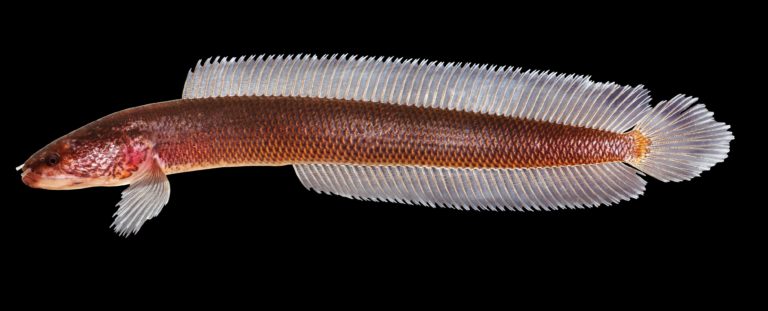Sahana Ghosh on 15 May 2019
The first snakehead fish with an underground lifestyle was hiding in the aquifers of Kerala until a chance encounter, social media and the historic floods of Kerala in 2018 thrust the species into the global spotlight.
The Gollum snakehead (Aenigmachanna gollum), a new genus and species, described from Kerala, is the first subterranean species of Channidae, the family of predatory freshwater fish called snakeheads.
It was described by researchers from Kerala University of Fisheries and Ocean Studies(KUFOS) and Natural History Museum, London, in a paper in the journal Zootaxa.
Eponymously named after JRR Tolkien’s iconic character in the series “The Lord of The Rings” due to its underground existence, the subterranean snakehead fish that showed up in a paddy field in Kerala, has both excited and stumped researchers.
The 9.2 cm-long eel-like fish appears to have bucked the trend followed by other subterranean fish species, according to the paper that describes the species.
Subterranean fishes generally share a number of characteristic features correlated with their life underground, such as reduction of eyes and enhancement of non-visual senses (taste, smell, mechanosensory systems).
But Ralf Britz, a researcher at the Natural History Museum who co-authored the paper describing the species, said, “Surprisingly, most of these characters that you find in other subterranean fishes are not developed in Aenigmachanna.”
“It still has eyes that are more or less the same size as its other snakehead relatives. There is pigment, though only shades of brown and black and not the typical bright colours of many snakeheads, and there is no non-optical sense that is enhanced,” Britz said.
“So in that respect, they do not resemble the other typical subterranean fish species,” Britz told Mongabay-India.
This could mean one of two things. Either the fish only acquired this subterranean mode of life recently, or it is living in some kind of transition zone where it is still moving between the underground and above-ground habitats. “We simply don’t know and so that is something we’d be very interested in finding out,” added Britz.
This is now the eighth species of subterranean fish that has come out of the aquifers beneath Kerala, leading researchers to believe that there must be a hidden ecosystem existing below the surface.
The discovery has also triggered concerns of changes in groundwater table impacting the hidden ecosystems harbouring the poorly known subterranean fauna.
“A depletion of the aquifers would have a seriously negative impact on this fascinating fauna, of which we have only seen a small fraction. The subterranean fishes and other subterranean animals of the aquifers of Kerala are not just another blind underground species. They are relic lineages, a witness of a very distant past and to lose them would mean to lose important, most precious pieces of the puzzle that is the evolution of life,” cautioned Britz.
From farm to lab
It all began with Mohammed Ajeer, a young fish hobbyist from Oorakam, a village known for its agricultural fields and spice trade in Kerala’s Malappuram district.
He chanced upon two individuals of the bizarre-looking fish in his paddy field after the devastating floods that hit Kerala in August last year (2018).
Pictures of the fish were posted online after the animals had seemingly been washed out of the aquifers – underground, permeable rocks that carry water. The images prompted the Kerala University of Fisheries and Ocean Studies (KUFOS) to investigate.
“Ajeer had realised that they were unusual and had posted it in online groups. We contacted him and he got us two specimens for research,” Rajeev Raghavan, assistant professor at KUFOS told Mongabay-India.
Britz adds: “There was an earlier image of a strange subterranean fish that was sent around social media groups in India about a year ago, which was sent to me at some point. It was not a very good image but when I saw that back then, I knew there was a strange fish hiding in the aquifers of Kerala.”
“And this fish had been taken from a well, which lends additional support to the idea that Aenigmachanna is a subterranean fish.”
As for the nomenclature, Britz said Gollum was his “very first thought”. “And I ran it past my co-authors. I think it is a fitting name,” he added.
My precious: Distinctive even among snakeheads
The new fish is also “highly distinctive” when compared to the known snakeheads.
Snakeheads are native to Africa and Asia and are distinguished by their long dorsal fins, large mouths, and ability to breathe air using what is known as a ‘suprabranchial organ’ in their gill cavity.
These fishes usually live in freshwater rivers or wetlands. Snakeheads, however, don’t tend to have any adaptations that might also be suited to an underground lifestyle.
What is immediately obvious is the subterranean Gollum snakehead has lost the ability to maintain buoyancy in the water column, so it has either reduced or lost its swim bladder, pointed out Britz.
“Aenigmachanna is unable to remain suspended in the water column and has either reduced or even lost its swim bladder, whereas all other channids (snakeheads) have a well-developed swim bladder and as highly efficient predators easily maintain buoyancy in open water,” the authors write in the study.
“Then it is much more elongated, anguilliform, we say than any other snakehead. And it has more anal fin rays and a very high number of scales and vertebrae. We do not have any information on its internal anatomy yet, but I am sure there will be some surprising and unique characters too in its skeleton and soft tissues,” Britz said.
The authors reckon that it is possible that some of these aspects could be adaptations to their underground existence.“If someone had told me there would be a subterranean snakehead I would have called him a liar,” Britz told Mongabay-India.
Globally, subterranean fishes are mainly represented by only two groups, the catfishes and carps, as the species in these groups are thought to be pre-adapted to life underground.
Britz explained: “Almost 3/4 of all subterranean fishes come from just two orders of bony fishes, the Cypriniformes (carps and relatives) and the Siluriformes (catfishes), whose members exhibit characters that could be interpreted as preadaptations to a successful life in the dark. But snakeheads are far from this.”
Terming the discovery as “unique”, A. Biju Kumar, of the Department of Aquatic Biology & Fisheries, University of Kerala, who was not associated with the study, said the fish raises questions not only on the biology but also biogeography.
“Subterranean ecosystems predominate the continental and ocean margins, and Indian land mass, especially the coastal states, may have a lot of interesting Gondwana relics. This fish, with arguments whether they are purely subterranean or a species that prefer to shuttle between subterranean and surface waters notwithstanding, poses a variety of interesting questions not only on its biological features (including the possibility for aestivation) but also on biogeography,” Biju Kumar told Mongabay-India.
“As air-breathing channiform fishes have close kins in both Africa and Asia, Aenigmachanna gollum may shed light on possible early Cretaceous divergence of the African and Asian channids and recent dispersal of this species between continents,” he said.
Advancing science through citizen’s participation
While serendipity plays a major role in the chance discoveries of subterranean fish species and other fauna, increasing awareness among local communities that these fish exist would also aid scientific investigations into hidden ecosystems, the researchers believe.
“All discoveries of subterranean fish species (and other subterranean animals like the amazing shrimp species Eurindicus bhugarbha recently described) are chance discoveries, in which serendipity plays a major role. You cannot go out and decide to sample the aquifers of Kerala in the same way as you could decide to sample all fishes of the Periyar river, for example,” Britz reasoned.
Britz emphasised encounters of subterranean fishes in Kerala will continue to depend on individuals like Ajeer who found Aenigmachanna and posted images on social media, which alerted professor Raghavan.
“So going out into the village communities and talking to local people will certainly enhance our chances to get additional specimens of known species, which we would need for follow-up studies on their anatomy, behaviour, reproduction, feeding, and obtain general info about their way of life,” said Britz, adding this is where citizen science projects can make a huge difference.
Raghavan said post the Gollum snakehead’s revelation, he and his colleagues have been getting calls on sightings of other fishes.
“But on investigating, we found they are already known species. However, it indicates that there is an increased awareness among locals on the potential finds. We intend to channelise this awareness into an organised campaign,” Raghavan said.
While inside the lab the team unpacks the anatomical and genetic secrets of the Gollum snakehead through advanced CT scans and molecular tools, outside on the field, the scientists have started prioritising areas for running awareness campaigns.
“Sometimes these fishes come through taps. Sometimes when wells are drained in summer for cleaning, these fishes pop up but people tend to kill them thinking it affects water quality. So we are trying to encourage them to keep a lookout for these fishes and not kill them,” observed Raghavan.“Subterranean fish is associated with laterite soil habitats so we are prioritising these areas and going to regions with wells,” added Raghavan.
Mongabay India




